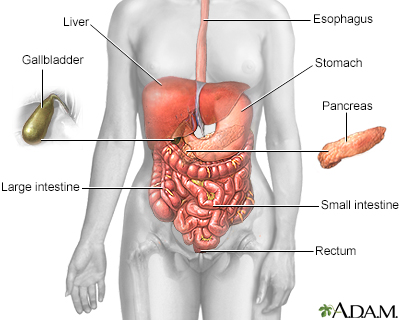Endoscopic ultrasound
Endoscopic ultrasound is a type of imaging test. It is used to see organs in and near the digestive tract.

The esophagus, stomach, large and small intestine, aided by the liver, gallbladder and pancreas convert the nutritive components of food into energy and break down the non-nutritive components into waste to be excreted.
How the Test is Performed
Ultrasound is a way to see the inside of the body using high-frequency sound waves. Endoscopic ultrasound does this with a thin, flexible tube called an endoscope.
- This tube is passed either through the mouth or through the rectum and into the digestive tract.
- Sound waves are sent out the end of the tube and bounce off the organs in the body.
- A computer receives these waves and uses them to create a picture of what is inside.
- This test does not expose you to harmful radiation.
If a sample or biopsy is needed, a thin needle can be passed through the tube to collect fluid or tissue. This does not hurt. Treatment of certain problems can also be done.
The test takes 30 to 90 minutes to complete. Often you will be given medicine to help you relax.
How to Prepare for the Test
Your health care provider will tell you what to do. You will be told when to stop drinking and eating before the test.
Give your provider a list of all the medicines you take (prescription and over-the-counter), herbs, and supplements. You will be told when you can take these. Some need to be stopped a week before the test. Ask your provider which medicines you should take on the morning of surgery.
Since you will not be able to drive or return to work on the day of this test, you will need someone to take you home.
How the Test will Feel
Before this test you will get medicine through an IV to help you relax (a sedative). You may fall asleep or not remember the test. Some people feel the test is slightly uncomfortable.
For the first hour after this test, you may feel sleepy and unable to drink or walk. You may have a sore throat. Air or carbon dioxide gas may have been put in your digestive tract during the test to move the tube more easily. This may make you feel bloated, but this feeling will go away.
When you are fully awake, you can be taken home. Rest that day. You may have fluids and light meals.
Why the Test is Performed
You may have this test to:
- Find the cause of abdominal pain
- Find the cause of weight loss
- Diagnose diseases of the pancreas, bile duct, and gallbladder
- Guide a biopsy of tumors, lymph nodes, and other tissue
- Look at cysts, tumors, and cancers
- Look for stones in the bile duct
- Deliver medicine to a part of the body
- Drain fluid from a part of the body
This test can also stage cancers of the:
Normal Results
The organs will appear normal.
What Abnormal Results Mean
The results depend on what is found during the test. If you do not understand the results, or have questions or concerns, talk to your provider.
Risks
Risks for any sedation are:
- Reactions to medicine
- Problems breathing
Complications from this test include:
- Bleeding
- A tear in the lining of the digestive tract
- Infection
- Pancreatitis
References
Gibson RN, Sutherland TR. The biliary system. In: Adam A, Dixon AK, Gillard JH, Schaefer-Prokop CM, eds. Grainger & Allison's Diagnostic Radiology. 7th ed. Philadelphia, PA: Elsevier; 2021:chap 24.
National Institute of Diabetes and Digestive and Kidney Diseases website. Upper GI Endoscopy.
Samarasena JB, Chang K, Topazian M. Endoscopic ultrasound and fine-needle aspiration for pancreatic and biliary disorders. In: Chandrasekhara V, Elmunzer BJ, Khashab MA, Muthusamy VR, eds. Clinical Gastrointestinal Endoscopy. 3rd ed. Philadelphia, PA: Elsevier; 2019:chap 51.
Wang KK. Gastrointestinal endoscopy. In: Goldman L, Cooney KA, eds. Goldman-Cecil Medicine. 27th ed. Philadelphia, PA: Elsevier; 2024:chap 120.
Version Info
Last reviewed on: 8/12/2024
Reviewed by: Jenifer K. Lehrer, MD, Gastroenterologist, Philadelphia, PA. Review provided by VeriMed Healthcare Network. Also reviewed by David C. Dugdale, MD, Medical Director, Brenda Conaway, Editorial Director, and the A.D.A.M. Editorial team.
